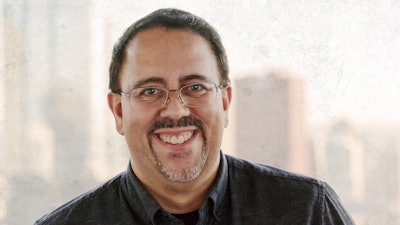Dr. Adrian Burgos, Jr., grew up playing and loving baseball. So did his mother, his grandmothers, and many of the people he grew up around. So, when it came time for him to pick an academic pursuit, the study of Latinos and sports history naturally came to mind.
 Dr. Adrian Burgos, Jr.
Dr. Adrian Burgos, Jr.
Burgos is an expert when it comes to U.S. Latino, African American, and sports history. He is a professor of history at University of Illinois Urbana-Champaign. He earned an associate degree in liberal arts from Orange County Community College, a bachelor’s degree in history from Vassar College, and a Ph.D. in history from the University of Michigan. His dissertation focused on Latinos, race, and baseball.
The professor studies the flow and migration of people, in particular, how individuals from Latin America came to, worked in, and were recruited to play baseball in the U.S. in the early 20th century. But his research is also a study of labor and perceptions. Recruited Latino baseball players were laborers after all.
"I want to use this as a kind of study where people could see [that] while these may be professional baseball players, they're experiencing many of the similar issues of cultural adjustment, institutions that they enter that are not prepared for these individuals who often were predominantly Spanish speaking ... [or] bilingual,” says Burgos. “There are still these perceptions in U.S. society about the abilities of people from the Caribbean and Latino America, their intelligence, and their work ethic. And baseball players – much the same as everyday workers – had to confront these perceptions in order to succeed."
Burgos says the cultural practices of Latinos were used as a way of racializing some of them, not as white nor Black, but as Brown. This resulted in certain Latino players being able to play major league baseball, while others – including African Americans and Afro-Latinos – were not allowed to do so. They instead played in the “Negro leagues.”
“The key component that I have argued was that this was more about racial perceptions than ability,” says Burgos, adding that most Latino players were regulated to the Negro leagues. “Because the majority of the best players were, in fact, Afro-Latino."
Burgos has written two books, Playing America’s Game: Baseball, Latinos, and the Color Line, which examines the U.S.’s segregated baseball color line, and Cuban Star: How One Negro League Owner Changed the Face of Baseball, which explores race dynamics and the life of Alejandro “Alex” Pompez, an Afro-Cuban-American Negro League team owner and major league baseball scout.
Burgos arrived at the University of Illinois Urbana-Champaign in 2001, where he earned tenure as an associate professor in 2007 and rose to full professor in 2012. He previously taught social relations as a visiting assistant professor at Michigan State University’s James Madison College. He is also a curator of ¡Pleibol! In the Barrios and the Big Leagues, a Smithsonian exhibit on Latino experiences as they relate to their love of and influences on baseball.
For his work, Burgos received commendations and awards such as the National Baseball Hall of Fame Grant from the Negro League Research/Authors Group, a Ford Foundation Postdoctoral Fellowship from the National Research Council; and the 2007 Latina/o Book Award from Latin American Studies Association. He is working on a biography of Orestes "Minnie" Miñoso, the first Afro-Latino to play major league baseball and the first Black player for the Chicago White Sox.
"Latinos have a long history in the U.S. that too often the focus when people think about Latinos in the U.S., they envision a recently arrived individual or family, when the vast majority of Latinos who are living in the U.S. are third generation-plus,” says Burgos. “There's a long history [of] involvement throughout the U.S. and American culture of Latinos."
Baseball became part of Cuban culture as early as the 1860s, when Cuban elites sent children to study in the U.S. instead of Spain. There, young Cubans learned the game and brought it back to their home country, establishing the sport as a mainstay in national culture, says Burgos. Other places in Latin America, including the Dominican Republic, Puerto Rico, and Venezuela, followed suit, playing baseball since the 1890s, he adds.
Though he looks at the past for his work, the discoveries he’s made are applicable even today, he says, specifically those about the labor market and social perceptions. He says Latino seasonal laborers come to the U.S. for work and leave after the season. Latino baseball players were much the same way. "There [are] parallels there, looking at how are you treated once you enter, once you were recruited into the labor force,” says Burgos. “Were there pathways to citizenship? Were there opportunities to remain in the U.S.? Did people see you as labor that's precarious and therefore exploitable?"





















